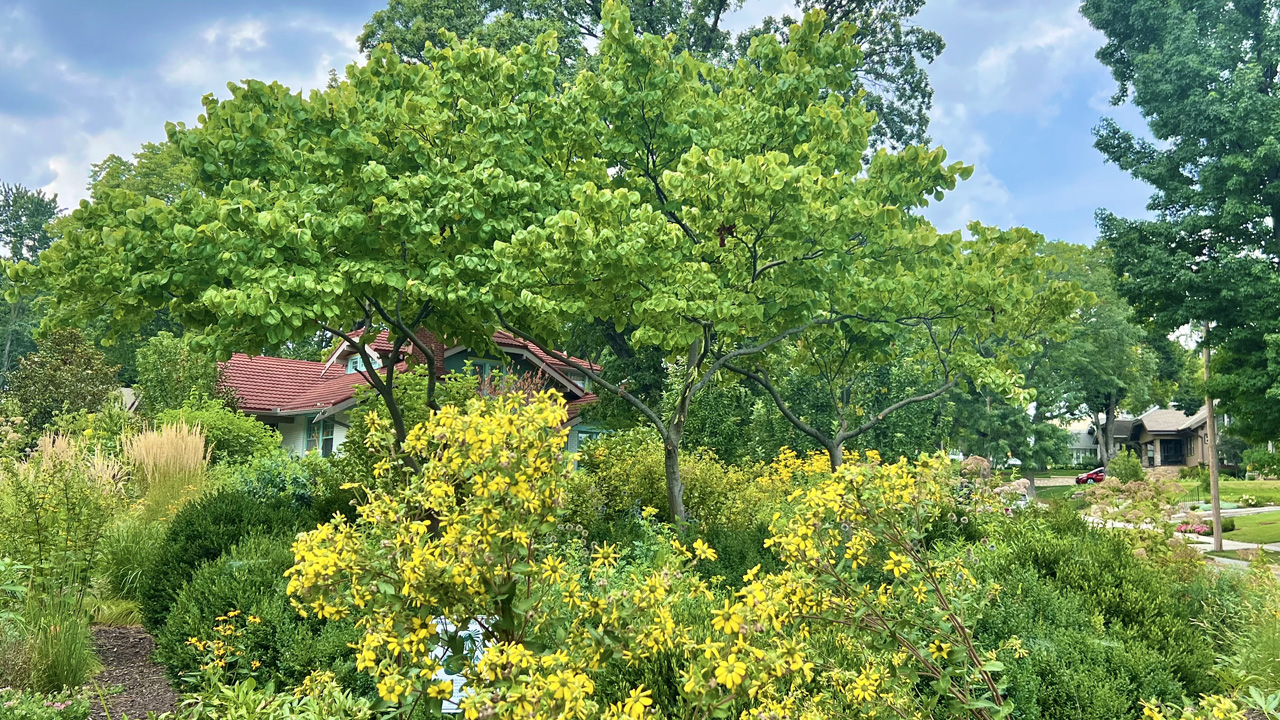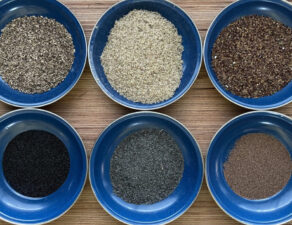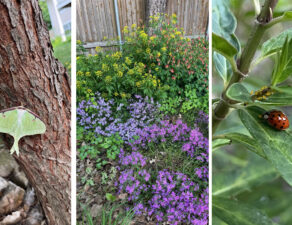
By Grace Suh
It’s September. The traditional garden season is winding down, and traditional garden tours stopped running long ago.
What’s still out there?
Birds. And butterflies, and bees. And all the other wildlife.
These three gardens in midtown are still beautiful, with plenty of late season blooms.
But they are also, in their own ways, great examples of the structure provided by density and layers — understory trees, shrub borders, native grasses, ground covers. This structure gives wildlife cover from predators, protection from weather, and safe sites for nesting and brooding. And long after the last bloom, this structure continues into winter and year-round.
Don’t worry — these are delightful, gorgeous gardens. But from a bird’s eye view, they are even more wonderful for the many ways their very structure creates rich, life-sustaining habitat.

HABITAT HAVEN
For the first dozen years Roberta and Stan lived in this Craftsman in Squier Park, the house was surrounded by the usual mix of weed trees, invasives like bush honeysuckle and Creeping Charlie, and old-fashioned garden standards like lilac and forsythia.
Although Roberta has worked most of her career in environmental fields, like most homeowners she had little time to think about the yard. Finally, she was forced to address the frequent flooding of the basement and garage, and a decrepit back deck that badly needed replacement.
An 1800-gallon cistern was installed below the new deck, with remaining runoff diverted to a large rain swale dug in the center of the side yard. The swale was then planted with moisture-loving shrubs like Button Bush, Blackhaw Viburnum, Chokeberry and Elderberry.
While this whole-scale solution was costly in the short term, it has meant no more water damage to the house. The native plants need no irrigation, fertilizer or other chemicals. The Rain Garden swale is surrounded by native plantings all around, divided into area by habitat, like the Woodland Edge shrub borders along the shady back property line, Moist Prairie on the sunny west face of the Rain Garden, and Glade plants on the berms and along the driveway. In fact, there is not a blade of turf to be found, just diverse, sustaining and very beautiful wildlife habitat.

ROCKHILL HERITAGE
Karen has lived in this historical neighborhood for 25 years but in this house for only two. A small residential island surrounded by large institutions — the Nelson-Atkins, Theis Park, and the Kauffman complex — Rockhill is a close-knit community, with a small-town spirit.
Several years ago, Karen moved away, looking for a change of scene. But the new neighborhood and house didn’t feel right. When this house came up for sale, just around the corner from her old one, she was thrilled to move back to Rockhill, where she was greeted with a welcome back party.
Though Karen’s new house is on a busy corner, the profuse flowers growing all along the frontage, on both busy Cleaver Boulevard and the tiny side street, make it look for all the world like a charming Cotswold cottage.
These gardens were already familiar to Karen, having been planted and grown by her former neighbor and friend Suzanne. Karen is now making them her own, with thoughtful edits and a deeply personal point of view. She has removed two invasive Callery Pear trees, installed backyard walkways, and added more native plants and shrubs, while accommodating practical considerations like the rambunctious chase games of her English Springer Spaniels. Karen’s juxtaposition of clear structure and lush beds creates beautiful views in all directions and in all seasons.

WEST PLAZA POLLINATOR
Dana and Mike are both gardeners, and moved here ten years ago from Fairway expressly for the larger, sunnier lot. Anyone would agree that they have optimized it beautifully.
Very little space is wasted on turf lawn, especially in the head-turning corner, which is brilliantly designed for its wedge-shaped, sloping contours, that bursts with blooms all season long.
Mike likes to say that Dana is “the Boss” and he is “the Brawn.” From the start, the Boss conceived of this showcase corner in terms of structure, sketching an oblong knot garden, named the Pollinator Parterre, which is delineated by shrubs. These are mostly boxwoods, joined later by shrubby perennials like Baptisia and Amsonia. Other substantial perennials like Joe Pye Weed and Texas Green Eyes create bold focal points along the vista.
Dana grows specialty cut flowers which she sells seasonally, so many of the garden’s plants have been chosen primarily for their potential as cut flowers. Yet they include a surprising number of natives. Dana’s sustainable flower arrangements are not only grown by Dana and Mike at their home, they also make stunning use of unusual native elements like Pokeweed berries and Baptisia seedpods.
After a visit to The High Line gardens in New York City several years ago, where he was particularly inspired by particular Oudolf’s use of ornamental grasses, Mike added sweeps of Prairie Dropseed (Sporobolus heterolepis) and Blue Grama (Bouteloua gracilis). And as a former beekeeper Mike has always emphasized pollinator-friendly blooms like goldenrods and asters.
All three September gardens offer wonderful inspirations to replace turf lawn with structure for wildlife and beauty for all.
HOW TO SIGN UP
If you’re not already a subscriber, we’d love to have you join us. SIGN UP FOR SEPTEMBER or SUBSCRIBE TO THE SEASON by making a donation of any amount, according to your means.
WHERE TO GO
The Thursday before each Second Saturday (September 12th), registrants and season subscribers receive an email with garden addresses. Click on the button to download the PDF of in-depth descriptions and key plants.
If you have not been seeing the emails, please note:
- The emails are sent from: Grace@deeprootskc.org
- The subject line will be: IMPORTANT 🌸 September Habitat Gardens 🦋 ADDRESSES & INFO
- If your Inbox has been filtering these emails, please add this address to your contacts so the email does not go to a junk or spam folder.
- If you do not see the email on September 12th, please email Grace@deeprootskc.org ASAP, as it is not possible to respond to phone calls and emails on the day of the tour.
WHAT IS A HABITAT GARDEN?
Habitat Gardens are gardens of native plants that provide habitat for birds, bees, butterflies and other wildlife.
Every Second Saturday Habitat Garden Tour invites you to three residential habitat gardens to:
- Experience diverse habitat gardens and the succession of seasonal blooms that support wildlife.
- Meet other gardeners, native plant enthusiasts and wildlife supporters.
- Find inspiration and information to grow your own habitat garden.
- Future and past Habitat Gardens: org/HabitatGardens







